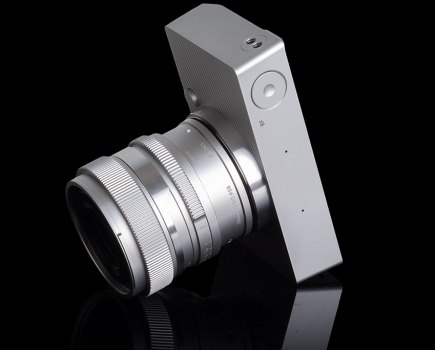Telephoto lenses are a topic of conversation among photographers perplexed by the range of options and wide disparity of costs. Lenses with equal focal lengths that differ in price by more than £1,000 are not unusual, and although we may baulk at the cost we know the more expensive models offer superior sharpness, focusing and depth of field.
Canon’s lens range is already extensive and includes two 70-300mm models: the f/4-5.6 IS USM and f/4.5-5.6 DO IS USM optics.
The new Canon EF 70-300mm f/4-5.6L IS USM is one of the company’s professional L-series models, in traditional off-white with the distinctive red ring around the front.
It sits alongside the EF 70-200mm f/4L IS USM and EF 100-400mm f/4.5-5.6L IS USM as a reasonably priced middle-ground optic, giving full-frame users a nice extra stretch from their standard zoom and APS-C users quite a powerful zoom with an equivalent focal length of 112-480mm.
This 70-300mm lens is certainly a better option than the 70-200mm f/4 models, and costs nearly £1,000 less than the EF 70-200mm f/2.8L IS II USM. However, the deciding factor will ultimately be the quality.
Features
The lens is constructed from 19 elements in 14 groups, including two Ultra-low Dispersion (UD) lenses to combat chromatic aberration. The aperture is created from eight blades, as on the latest 70-200mm models, for a smoother bokeh in the out-of-focus areas of your pictures. Focusing is achieved through a USM (Ultra Sonic Motor) for fast and silent operation, while allowing manual override at any time.
The zoom extends the length of the lens by up to 6cm at full extension, and so a lens lock is present to prevent the zoom creeping. A focus window sits towards the back of the unit, with focal distances in feet and metres, and markers for the various focal-length positions.
Three switches on the side control auto/manual focus selection, stabilisation and stabiliser mode, between mode 1 (full stabilisation) and mode 2 (vertical only) for panning. The system offers up to 4EV in added stability, which will make a considerable difference at full extension.
Unlike the 70-200mm lens there is no focus limiter, which seems unusual considering the added length. The focus ring sits in the centre with the zoom ring at the front, suggesting that the zoom will be used most often.
The front optic is just 67mm in diameter thanks to the smaller apertures offered. The aperture range is not unusual for a lens of this length, but I feel users would have accepted a slightly larger unit, perhaps 77mm, if it had a straight f/4 aperture instead of the variable f/4-5.6.
Build and handling
The lens is compact for its specification, but is still chunky enough to suit a range of EOS bodies up to the EOS-1D and 1Ds. The focus ring is smooth and precise, with positive feedback thanks to its direct connection to the lens barrel. Although it is useful for manual override, the ring’s central position means it can be knocked when accessing the zoom ring.
It seems a little basic for a branded professional lens to have an extending zoom barrel, but it is understandable for a lens of this size and looks solid when extended.
Focusing and aperture
Canon EF 70-300mm f/4-5.6L IS USM Focusing
The USM motor performs admirably, providing extremely fast, near silent focusing.
The motor flew through the range, even compared to our EF 70-200mm f/2.8L IS USM control model, and produced less noise during the travel. This is a lens that would suit use inside a church for a wedding or out in a bird hide.
The manual-focus control is also very easy to use, with a nice wide area designated macro for distances between 1.4m and 3m, and room past infinity for the autofocus system to work efficiently.

Image (left): Taken at 200mm f/2.8, the image is crisp with a very shallow depth of field, requiring very precise focus adjustment. Image (right): Taken at 200mm f/5, the image is extremely crisp and still allows the depth of field to fall off around the hair
Canon EF 70-300mm f/4-5.6L IS USM Aperture
Many photographers will be put off this lens because of the f/4-5.6 aperture, but in practice it is less of an issue than you may think. Using the lens for portraits, the aperture allows you greater room for movement around your subject, ensuring that the eyes stay in crisp focus.
The difference in defocused areas between f/4 and f/2.8 is very subtle. Plus, those working in low light will benefit from the 4 stops of stabilisation, which means that even at full extension the lens can be used in lower light than a non-stabilised f/2.8 lens.
However, one downside is that the lens isn’t recommended for use with Canon’s 1.4x or 2x extenders, as the maximum aperture would become f/8 or f/11 at full extension. Had this been a straight f/4 lens, like the cheaper of the 70-200mm L-series options, it would be more suited to extender use.
Image sharpness, quality and resolution
The sweet spot of the lens is between f/11 and f/16, and sharpness is consistent from 70-200mm here, only falling slightly towards 300mm. The maximum apertures of f/4-5.6 also stay sharp throughout, but values smaller than f/22 become very soft and are best avoided.
Across the range, the 70-300mm lens is just as sharp as the 70-200mm control lens at both the 70-300mm’s maximum aperture and at f/11, which is very impressive. However, the 70-200mm optic keeps more sharpness at smaller apertures, especially at 70mm.
There is some slight barrelling at the wide end and pincushioning at the telephoto end, but not to an alarming degree. Towards the edges of the frame there are also some signs of chromatic aberrations, but these are minor and easily corrected.
Image stabilisation is very effective in the lens and I could certainly achieve an extra 3 stops when shooting with a fairly steady hand.
Resolution

We placed the EF 70-300mm f/4-5.6L IS USM on a Canon EOS-1Ds Mark III body and shot our standard test chart. Images were then taken at a range of focal lengths and apertures. The EF 70-200mm f/2.8L IS was also used on the same camera body to show a comparison for the image quality at each aperture.
Our verdict
Canon’s EF 70-300mm f/4-5.6L IS USM lens doesn’t have the impressive numbers you would expect from a professional optic, especially in the aperture range, and its compact size has meant some of the sleek features such as internal zoom haven’t been possible.
However, this lens is small in stature and in price, and while you could buy a 70-200mm f/4 for less, by the time you added the 1.4x extender the price would be practically the same and the unit would be considerably larger.
Where this lens excels, though, is in the quality, holding its own against a lens considered to be one of the best in its day. For this reason, not only does this lens deserve its professional status but it is also a great buy.









